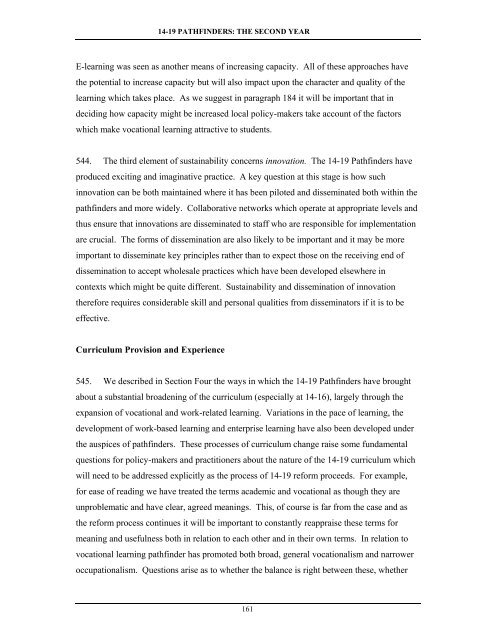Collaborative Approaches to 14-19 Provision - Communities and ...
Collaborative Approaches to 14-19 Provision - Communities and ...
Collaborative Approaches to 14-19 Provision - Communities and ...
- No tags were found...
Create successful ePaper yourself
Turn your PDF publications into a flip-book with our unique Google optimized e-Paper software.
<strong>14</strong>-<strong>19</strong> PATHFINDERS: THE SECOND YEARE-learning was seen as another means of increasing capacity. All of these approaches havethe potential <strong>to</strong> increase capacity but will also impact upon the character <strong>and</strong> quality of thelearning which takes place. As we suggest in paragraph 184 it will be important that indeciding how capacity might be increased local policy-makers take account of the fac<strong>to</strong>rswhich make vocational learning attractive <strong>to</strong> students.544. The third element of sustainability concerns innovation. The <strong>14</strong>-<strong>19</strong> Pathfinders haveproduced exciting <strong>and</strong> imaginative practice. A key question at this stage is how suchinnovation can be both maintained where it has been piloted <strong>and</strong> disseminated both within thepathfinders <strong>and</strong> more widely. <strong>Collaborative</strong> networks which operate at appropriate levels <strong>and</strong>thus ensure that innovations are disseminated <strong>to</strong> staff who are responsible for implementationare crucial. The forms of dissemination are also likely <strong>to</strong> be important <strong>and</strong> it may be moreimportant <strong>to</strong> disseminate key principles rather than <strong>to</strong> expect those on the receiving end ofdissemination <strong>to</strong> accept wholesale practices which have been developed elsewhere incontexts which might be quite different. Sustainability <strong>and</strong> dissemination of innovationtherefore requires considerable skill <strong>and</strong> personal qualities from dissemina<strong>to</strong>rs if it is <strong>to</strong> beeffective.Curriculum <strong>Provision</strong> <strong>and</strong> Experience545. We described in Section Four the ways in which the <strong>14</strong>-<strong>19</strong> Pathfinders have broughtabout a substantial broadening of the curriculum (especially at <strong>14</strong>-16), largely through theexpansion of vocational <strong>and</strong> work-related learning. Variations in the pace of learning, thedevelopment of work-based learning <strong>and</strong> enterprise learning have also been developed underthe auspices of pathfinders. These processes of curriculum change raise some fundamentalquestions for policy-makers <strong>and</strong> practitioners about the nature of the <strong>14</strong>-<strong>19</strong> curriculum whichwill need <strong>to</strong> be addressed explicitly as the process of <strong>14</strong>-<strong>19</strong> reform proceeds. For example,for ease of reading we have treated the terms academic <strong>and</strong> vocational as though they areunproblematic <strong>and</strong> have clear, agreed meanings. This, of course is far from the case <strong>and</strong> asthe reform process continues it will be important <strong>to</strong> constantly reappraise these terms formeaning <strong>and</strong> usefulness both in relation <strong>to</strong> each other <strong>and</strong> in their own terms. In relation <strong>to</strong>vocational learning pathfinder has promoted both broad, general vocationalism <strong>and</strong> narroweroccupationalism. Questions arise as <strong>to</strong> whether the balance is right between these, whether161
















